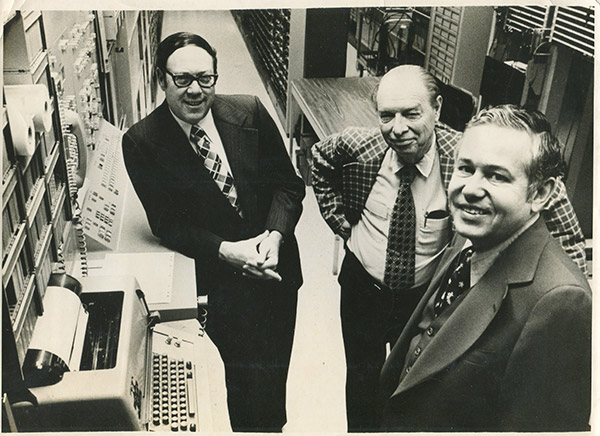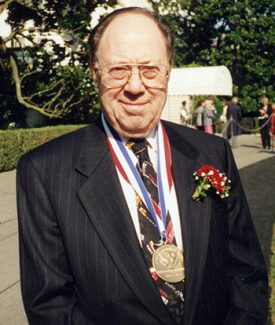FATHER OF THE CELL PHONE
Amos E. Joel, Jr.
INVENTOR - ENGINEER
“It’s not really re-inventing the wheel that you worry about, but people do tend to get certain things from relooking at old ideas with new technology.” ---Amos E. Joel, Jr.

Illustration by Robert De Michiell
Per Merriam-Webster, the definition of “cell phone” is “a portable, usually cordless telephone for use in a cellular system.”
The name derives from the basic concept of cellular networks. Network towers were installed on the ground to provide connection to subscribers. The land area was divided into smaller units called “cells,” each of which had their own network towers.
In 1947 engineers from Bell Telephone Laboratories (Bell Labs), Douglas H. Ring and W. Rae Young, set out to develop a network of wireless towers which they called “cellular.” For these towers to function, a system had to be developed.
Succinctly, the MOBILE COMMUNICATION SYSTEM enables the user to place phone calls while moving from one cell region to another, without losing their connection. Mr. Joel’s 1972 cellular phone system patent opened the pathway for the cellular phone business. This is why one may just consider Mr. Joel, the father of the cell phone.

1972 Cell Phone System Patent
His switching device opened the way for the cellular phone business.
While Martin Cooper is credited for “inventing” the mobile phone for Motorola in 1973, His first wireless handset relied on a single base tower, linked up with the landline system, and had limited range. Wireless phones would eventually work “one the move,” as a result of Mr. Joel’s patent. This is why he should be included as a founding Father of the cell phone.
One of Mr. Joel’s supervisors at Bell Labs, Frank Vigilante, stated “Without his invention, there wouldn’t be all these people walking around with cellphones. Mr. Joel really allowed that business to form and be a business.”
From an early age, Mr. Joel was interested in the area of telecommunications-and more specifically electronic switching systems. At Bell Labs, where he worked for 43 years, engineers guided the development of new electronic switching networks from simple prototypes to computerized central offices of massive scale (Nebeker/”Sparks of Genius”).
In the 1960s, Mr. Joel became one of the leaders and designers of ATT’s first electronic switching networks (#1ESS). Throughout his career, he contributed to the evolution of electronic switching as a formal field of engineering science. All of these interests contributed to his development of the MOBILE COMMUNICATION SYSTEM.

Historically, Mr. Joel’s academic and professional associations with other inventors/engineers helped contribute to the development of this technology:
While studying at MIT in the 1930s, he met Claude Shannon (Father of Information Theory), who inspired his master’s thesis on the application of Boolean algebra to the design of relay and switch circuits.
After graduation from MIT in the 1940’s (His yearbook called him “God’s Gift to the Telephone Industry”), Mr. Joel joined Bell Labs. When war was declared in 1941, Mr. Joel worked on projects re: military cryptographic systems that used electromechanical relays and complex switching circuits. These wartime technologies contributed to the growth of post war development on electronic telephone switching.

At Bell Labs, after the war, Mr. Joel worked with talented engineers—among them, Bill Keister; Ray Ketchledge; Al Ritchie; and Dick Jaeger developing the first commercial electronic switching system (#1ESS). A major benefit of #1ESS was that it presented a leap forward in the complexity and sophistication of switching equipment (Bell Technical System Journal 1964).
Throughout his tenure at Bell Labs, Mr. Joel continued to design new ancillary devices to keep the older switching technologies working in conjunction with newer telephone services. After directing the Bell Labs’ switching laboratory, he became “Director Without Portfolio,” which gave him freedom to contribute his vast knowledge to other departments with Bell Labs. It also gave him more time to develop the technologies leading to the MOBILE COMMUNICATIONS SYSTEM patent. Among the engineers with whom he worked during this time were Joel Engel and Richard Frenkiel, key architects of cellular networks, which was the basis for Advanced Mobile Phone System, eventually commercialized in the 1980’s.
It is important to note that Mr. Joel’s patent became a cornerstone for ATT and Bell Labs entering the cellular market. “Motorola feared that ATT would enter the cellular market and use its monopoly power to crush any competition.” (Gertner/The Idea Factory) However, ATT made a concession stating that it would only seek permission from the FCC to build and operate networks. This opened the handset business to companies like Motorola and other Japanese vendors. (Gertner/The Idea Factory)
Throughout his career, Amos Joel received more than 70 patents and has been recognized internationally at the Father of Switching (who connected the world). As such he has received numerous awards, most notably:
– The Stuart Ballantine Medal from the Franklin Institute
– Induction into the National Inventors Hall of Fame
– The Kyoto Prize
– The Medal of Honor from the Institute of Electrical and Electronic Engineers
– The National Medal of Technology
For more information on Amos E. Joel, Jr., go to amosjoel.com

